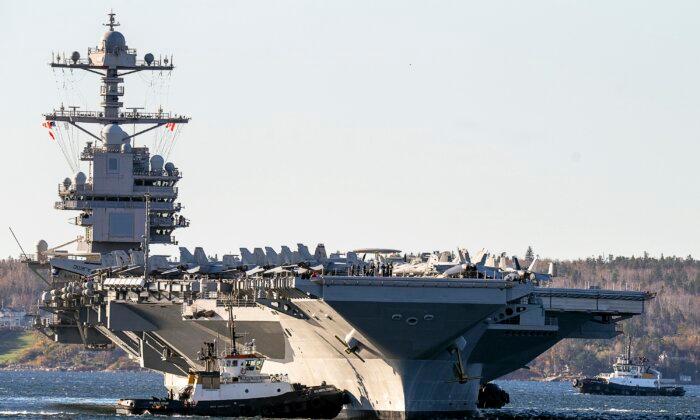The United States has sent or redirected much more than 15,000 military personnel to the Middle East since the Israel–Hamas conflict began on Oct. 7, officials recently confirmed.
While the United States has stated that it has deployed about 1,200 new troops to the region since early October, about 10,000 sailors are currently on the USS Gerald R. Ford and USS Dwight D. Eisenhower carrier strike groups, which were redirected to the Middle Eastern portion of the Mediterranean Sea. Another 4,000 sailors and Marines were also deployed along with the Bataan amphibious ready group.
The USS Eisenhower currently includes about 5,000 crew members, according to a statement from the U.S. Navy. The USS Ford has about 4,500 crew members on board.
However, a Navy spokesperson told CNN and Fox News that the USS Ford and USS Eisenhower strike groups each have 6,000 troops. The Pentagon didn’t respond to a request for comment by press time.

US Deterrence Efforts
On Oct. 31, the Department of Defense announced that 300 more troops would be added to the 900 troops that were sent to the Middle East in October. The latest forces will deploy to undisclosed locations in the region but outside of Israel, according to Pentagon spokesman Brig. Gen. Pat Ryder.“They are intended to support regional deterrence efforts and further bolster U.S. force protection capabilities,” he said.
That includes personnel who will operate the U.S. Terminal High Altitude Area Defense, or THAAD, missile defense systems that were confirmed to have been deployed in the region in recent days.
Before the recent military developments, the United States had maintained a force of several hundred troops who were stationed in Iraq and Syria, following the conflict with the ISIS terrorist group that took over parts of both countries in the 2010s. The Pentagon also confirmed the deployment of fighter aircraft to the region.
The general said steps have been taken to increase the protection of U.S. forces in the region, which “has prevented more serious casualties of our forces in theater.”
In October, the USS Carney destroyer shot down multiple missiles and drones that were launched by the Iran-backed Houthis militia in Yemen, according to the Pentagon. The missiles were likely traveling to Israel, according to Brig. Gen. Ryder.
“We cannot say for certain what these missiles and drones were targeting, but they were launched from Yemen heading north along the Red Sea, potentially to targets in Israel.”

US Submarine in Mediterranean
On Nov. 5, the U.S. Central Command announced the arrival of one of its Ohio-class submarines in its area of responsibility, which includes the Middle East and Central and South Asia. Ohio-class submarines generally have 155 crew members, according to the Submarine Industrial Base Council.A Pentagon official told The Associated Press that the submarine isn’t armed with nuclear weapons, coming after Brig. Gen. Ryder said that it would “further support our deterrence efforts in the region.”
Although it isn’t unusual for a U.S. submarine to transit the canal in Egypt, Central Command’s online statement acknowledging the location of an Ohio-class submarine is rare. There are Ohio-class submarines that can fire nuclear weapons, known as SSBN or ballistic missile submarine variants.
On Nov. 6, Brig. Gen. Ryder said U.S. troops stationed in Iraq and Syria have been attacked by drones or rockets 38 times since Oct. 17. So far, about 46 service members have been injured, he said.
This comes amid a visit by CIA Director William Burns to the Middle East to meet with intelligence partners and leaders of several countries on matters including ones related to the war between Israel and Hamas, officials said on Nov. 6. Topics include the fate of about 240 foreigners being held hostage by the Hamas terror group in Gaza and the U.S. commitment to prevent state and nonstate actors from widening the Israel–Hamas war regionally.







